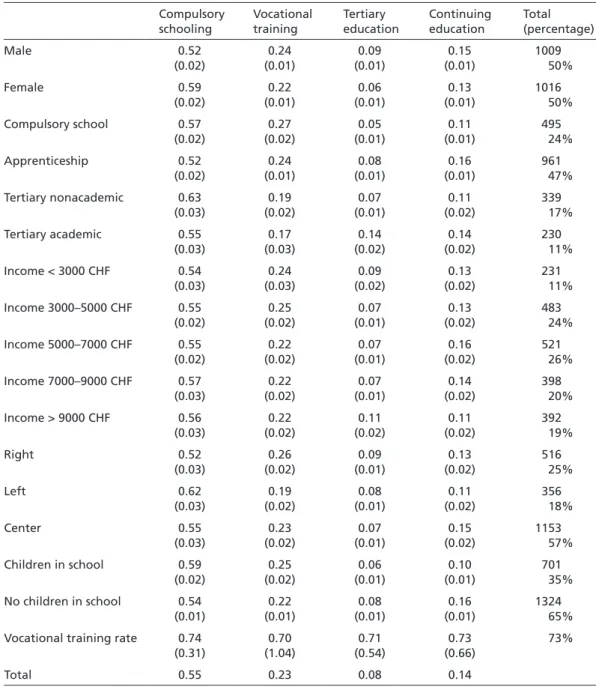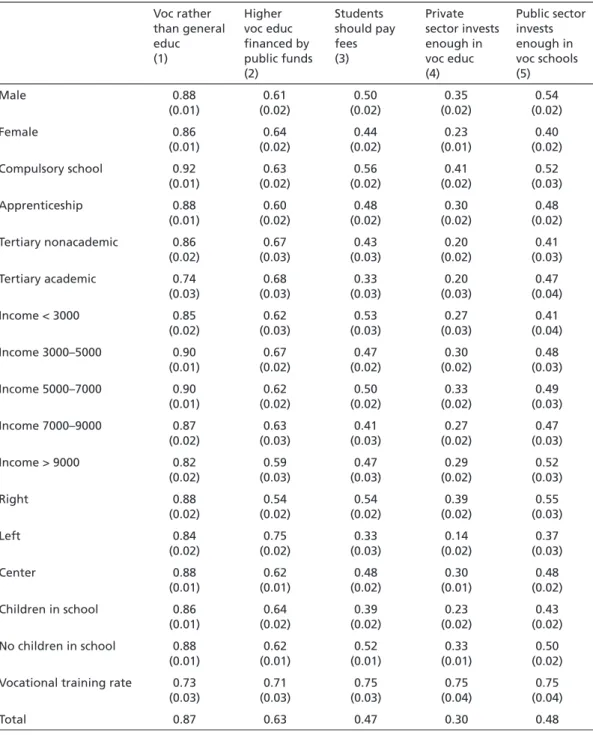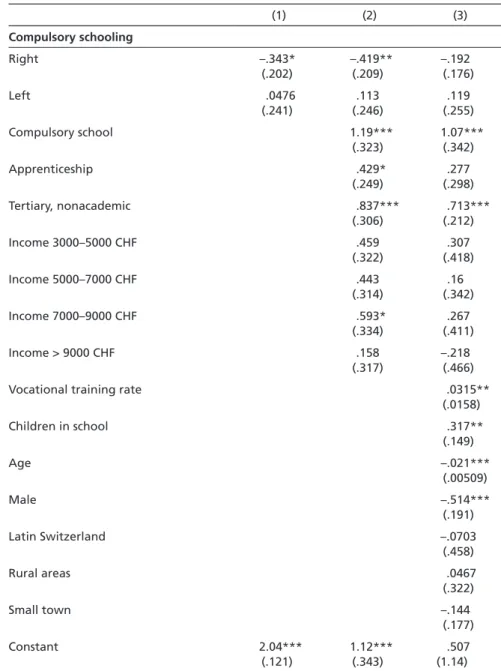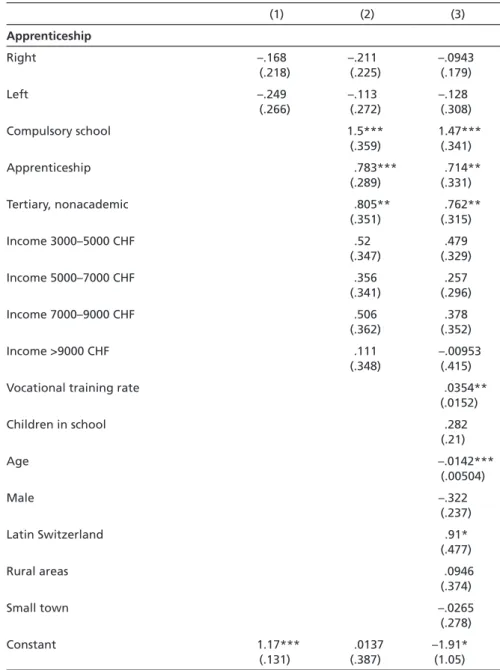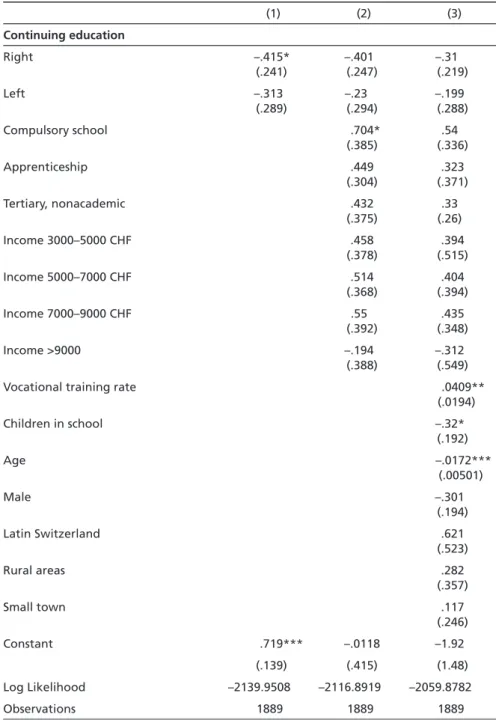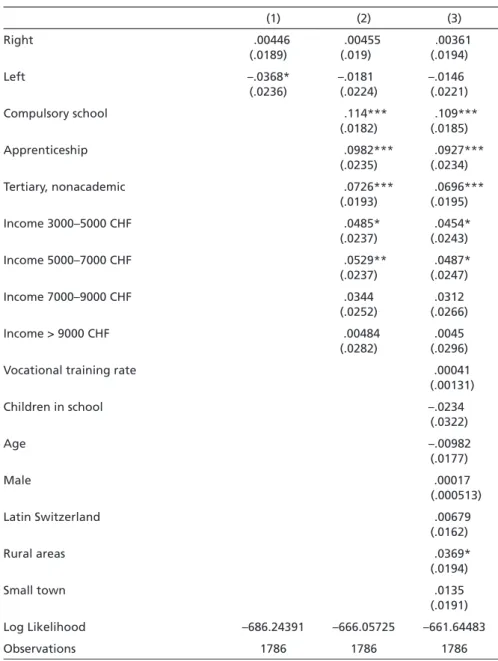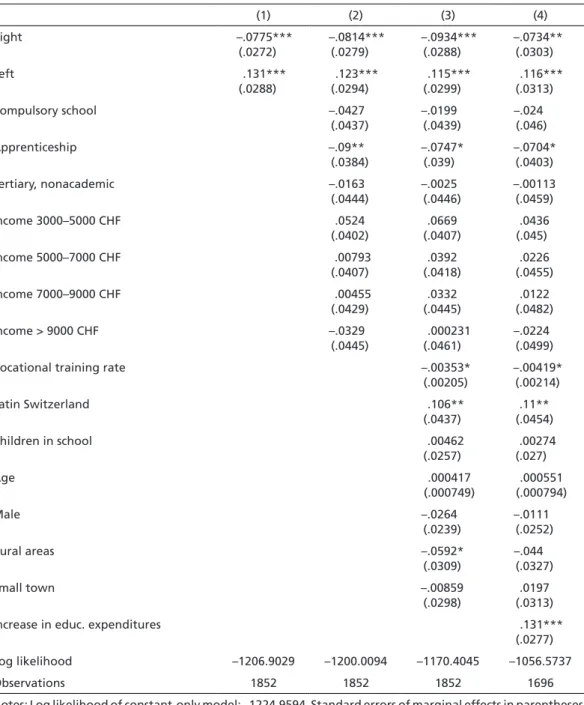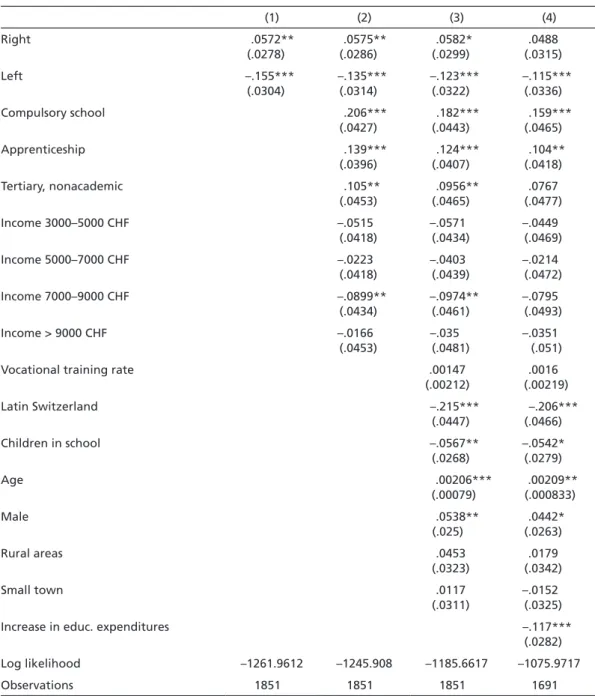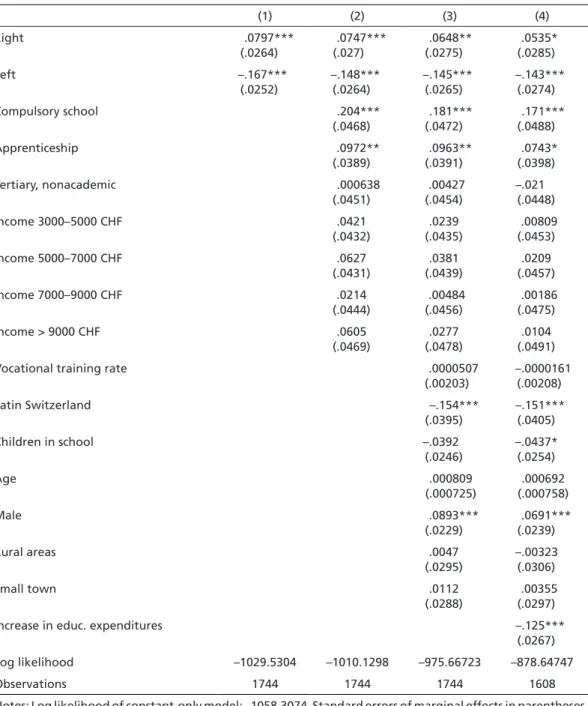Individual Policy Preferences for Vocational versus Academic Education
Micro Level Evidence for the Case of Switzerland
Marius R. Busemeyer, Maria Alejandra Cattaneo,
and Stefan C. Wolter
Max-Planck-Institut für Gesellschaftsforschung, Köln Max Planck Institute for the Study of Societies, Cologne September 2010
MPIfG Discussion Paper ISSN 0944-2073 (Print) ISSN 1864-4325 (Internet)
© 2010 by the author(s)
Marius R. Busemeyer, Max Planck Institute for the Study of Societies, Cologne busemeyer@mpifg.de
Maria Alejandra Cattaneo, Swiss Coordination Centre for Research in Education (SKBF-CSRE), Aarau maria.cattaneo@skbf-csre.ch
Stefan C. Wolter, University of Bern, Centre for Research in Economics of Education, and Swiss Coordination Centre for Research in Education (SKBF-CSRE), Aarau
stefan.wolter@skbf-csre.ch
MPIfG Discussion Papers are refereed scholarly papers of the kind that are publishable in a peer-reviewed disciplinary journal. Their objective is to contribute to the cumulative improvement of theoretical knowl- edge. The papers can be ordered from the institute for a small fee (hard copies) or downloaded free of charge (PDF).
Downloads www.mpifg.de
Go to Publications / Discussion Papers
Max-Planck-Institut für Gesellschaftsforschung Max Planck Institute for the Study of Societies Paulstr. 3 | 50676 Cologne | Germany
Tel. +49 221 2767-0 Fax +49 221 2767-555 www.mpifg.de info@mpifg.de
to explore the dynamics of education policy preferences. This issue has largely been neglected so far as most studies on welfare state attitudes do not look at preferences for education. We argue that education policy preferences vary along two dimensions:
the distribution of resources across different sectors of the education system (i.e. voca
tional training vs. academic education) and the level of investment in education both from public and private sources. With regard to the former, the findings suggest that individual educational experience matters most, i.e., individuals prefer to concentrate resources on those educational sectors that are closest to their own educational back
ground. With regard to the second dimension, we find that affiliation to partisan ide
ologies matters much more than other variables. Proponents of the left demand more investment both from the state as well as from the private sector and oppose individual tuition fees.
Zusammenfassung
Dieses Papier untersucht die Dynamik bildungspolitischer Präferenzen auf der Mikro
ebene. Dabei werden Daten aus einer eigenen Erhebung verwendet, die im Jahr 2007 in der Schweiz durchgeführt wurde. Die Untersuchung bildungspolitischer Präferenzen wurde in der einschlägigen Literatur zur Untersuchung von wohlfahrtsstaatlichen Ein
stellungen bisher vernachlässigt. Wir zeigen, dass bildungspolitische Präferenzen auf zwei Dimensionen zu verorten sind: zum einen die Verteilung von öffentlichen Mitteln auf verschiedene Bildungssektoren (berufliche vs. hochschulische Bildung) und zum anderen das Gesamtniveau der Bildungsausgaben. In Bezug auf die erste Dimension stellen wir fest, dass der individuelle Bildungshintergrund sehr prägend ist. Die Befrag
ten unterstützten die Konzentration von öffentlichen Mitteln in denjenigen Bildungs
bereichen, die sie aus der eigenen Bildungskarriere kennen. In Bezug auf die zweite Dimension lassen sich hingegen starke ideologische Effekte feststellen. Individuen, die sich ideologisch im linken Spektrum verorten, fordern mehr Bildungsausgaben vonsei
ten des Staates und des Privatsektors und lehnen Studiengebühren eher ab.
Contents
1 Introduction 5
2 Literature review 6
3 Theoretical framework 9
Income and educational background 10
Partisan identification 12
Institutions 13
4 Data and methods 14
5 Descriptive data 18
6 Empirical results 20
Which educational sector should receive more
public funding in the future? 21
Who should pay for the education costs? 26
7 Summary and conclusions 31
References 32
1 Introduction
This paper studies the determinants of individual preferences on education policy, an issue that has not yet been studied systematically in the pertinent literature. Although a sizable body of literature researching the welfare state has analyzed the determinants of individual preferences on various welfare state policies (for a more detailed review, see below), it has paid little attention to education. Additionally, the work in the field of educational sociology concentrates on studying the determinants of actual educational choices, i.e. transitions from one level of education to the next, but not so much the preferences on education policies as such.
We borrow from these two strands of literature to develop an explorative theoretical framework, focusing on the contribution of educational background, income, partisan affiliation, and institutions to explain education policy preferences. More specifically, we look at two dimensions of variation in education policy preferences: the first dimen
sion is the distribution of public resources amongst different types of education, such as vocational training, higher education, or compulsory schooling; the second alludes to the role of the state in financing education in relation to private actors, such as in
dividuals or training firms. In the empirical section, we rely on original data from a representative survey conducted in Switzerland in 2007.
To disclose our findings: educational background and income are important determi
nants of individual policy preferences concerning the distribution of public education spending across different sectors such as academic education versus vocational training.
Individuals tend to support the concentration of public funding in those educational sectors from which they have emanated themselves. However, when it comes to the level of public funding, educational background and income have little explanatory power.
Instead, partisan ideology becomes the dominant determinant of preferences, with pro
ponents of the left demanding more investments in human capital – both from private as well as public sources. Also, we find that institutional context matters: concentrating public spending on vocational training is more popular in Swiss cantons with a strong tradition in vocational education.
The study of education policy preferences is important from a theoretical as well as an empirical perspective. In democratic societies, the policy preferences of individual vot
ers matter. Of course, although voter preferences are aggregated and filtered by inter
mediary associations, political parties, and institutions, studies have shown that there is a link between individual attitudes and policy output (Wlezien 1995). Boeri, Börsch
Supan, and Tabellini (2001) document how widespread individuallevel support for the welfare state poses a formidable obstacle to farreaching welfare state retrenchment.
Thus, we hope that the study of education policy preferences will contribute to improv
ing our understanding of continuity and change in contemporary education systems.
In particular, the study of the Swiss case can yield answers to the question whether vo
cational training will remain a viable alternative to academic education in the future or
whether the lack of individual support for maintaining routes of vocational education will lead to its eventual decline.
The paper is structured as follows: in the first section, we present a brief review of stud
ies in comparative welfarestate research and educational sociology, identifying the spe
cific shortcomings of these works and how our paper addresses them. Following that, we develop an explorative theoretical framework, which is then tested in the empirical section with data from Switzerland. The final section concludes and discusses avenues for future research.
2 Literature review
Since the late 1980s (Hasenfeld/Rafferty 1989; Papadakis 1993), a sizable literature on the individuallevel determinants of social policy preferences has developed. One strand within this growing body of work is rooted in political sociology (e.g. Roller 1999; Arts/Gelissen 2001; Blekesaune 2007; Blekesaune/Quadagno 2003; Jaeger 2009;
Kangas 1997, 2003; Lipsmeyer/Nordstrom 2003; Lynch/Myrskylä 2009; Van Oorschot 2006), whereas another analyzes preferences for redistribution from the perspective of political economy (Alesina/Angeletos 2005; Alesina/La Ferrara 2005; Alesina/Glaeser/
Sacerdote 2001; Amable 2009; Benabou/Ok 2001; Corneo/Grüner 2000, 2002; Cusack/
Iversen/ Rehm 2006; Fong 2001; Iversen/Soskice 2001; Kenworthy/McCall 2008; Piketty 1995; Rehm 2009; Scheve/Stasavage 2006). Although direct interaction and crossrefer
encing between these two strands of literature is often lacking, some parallels between the core findings have emerged over the years.
For one, and maybe most importantly, both selfinterest and ideology matter in the explanation of differences in social policy preferences (Corneo/Grüner 2002; Fong 2001; Hasenfeld/Rafferty 1989; Kangas 1997; Papadakis 1993). General support for the welfare state or redistribution is negatively correlated with income on the micro level, because the poor can expect to benefit more from generous welfare state policies than the rich (but see Moene and Wallerstein 2003 for a different argument). Moreover, for individual social policies with different redistributive implications, it has been shown that those who expect to benefit from the program in question are also more support
ive of its existence (Hasenfeld/Rafferty 1989; Kangas 2003; Van Oorschot 2006). More recent work emphasizes the importance of labor market risk (Rehm 2009). According to Iversen and Soskice (2001), people with more specific skills are more supportive of redistribution, because they face a greater risk of income loss in case of unemployment.1
1 In a related argument, Wasmer (2006) theoretically demonstrates that a bounteous welfare state could be a condition necessary to prompt people to invest in occupationspecific skills versus general skills (typically, vocational education as opposed to academic education), because the
Thus, in sum, the selfinterest hypothesis states that policy preferences of individuals are largely determined by their economic position in the context of both the general economy and the welfare state.
However, research has also demonstrated that selfinterest alone cannot account for the observed variety of policy preferences. Ideological orientations matter in addition to and beyond pure selfinterest. In classic research designs, this question is framed in terms of the explanatory power of belonging, on the one hand, to various “transfer classes,” which are based on differences in access to the benefits of welfare state policies, and on the other, to politicoeconomic classes (i.e., labor and the bourgeoisie) (Pa
padakis 1993). Transferclass cleavages (e.g., old age in the case of pensioners) can cut across politicoeconomic cleavages, so that evidence for the relevance of transfer classes is interpreted as support for the thesis of selfinterest, whereas the continued existence of political alignment within politicoeconomic classes is taken as support for the rel
evance of ideological factors. Hence, the relevance of partisan ideology in addition to and beyond economic selfinterest can simply be controlled for in multivariate regres
sion analyses by including partisan selfidentification as an independent variable (e.g., in Bean and Papadakis 1998).
In addition to partisan ideology, general value orientations matter as well. Van Oor
schot highlights the importance of perceptions of “deservingness” for individual sup
port regarding different welfare policies (Van Oorschot 2006). Policies aimed at groups of people that are perceived as “deserving,” such as old, sick, and disabled people, find more support than policies for the “undeserving,” such as immigrants. His findings are similar to those in a strand of research in political economy that shows that indi
viduals who believe that social and economic hardship is a consequence of bad luck or fate are more supportive of redistribution than individuals who attribute hardship to individual idleness (Alesina/Glaeser/Sacerdote 2001; Fong 2001; Corneo/Grüner 2002;
Alesina/Angeletos 2005; Alesina/La Ferrara 2005). Scheve and Stasavage (2006) dem
onstrate how redistributive preferences are also associated with religious orientations.
More religious persons are less supportive of redistribution because their faith lowers the psychological costs of hardship.
Institutional context also matters, although in this field of research, the findings are less conclusive and more ambiguous than in the previous ones. A classical topic in compara
tive welfare state research is to probe whether welfare state institutions shape individual preferences. Rothstein (1998) argues convincingly that “just” institutions (i.e., universal welfare state institutions that are perceived as being fair) increase the support for the welfare state in general. In line with this argument, a number of studies have looked at the association between the clustering of support for social policies and EspingAn
dersen’s “worlds of welfare capitalism” (EspingAndersen 1990) with the expectation more specific the skills are, the greater the risk of remaining unemployed is when the labor market undergoes periods of structural change.
that support for the welfare state would be strongest in the Scandinavian countries and lowest in the AngloSaxon world (Papadakis 1993; Bean/Papadakis 1998; Arts/Gelissen 2001; Blekesaune/Quadagno 2003; Lipsmeyer/Nordstrom 2003). The results, however, are far from conclusive. Differences in support between countries do not necessarily vary in line with the worlds of welfare capitalism, although recent work by Jaeger (2009), using a new methodological approach, seems to yield more robust results. Nevertheless, a crucial finding is that welfare state policies are popular in general, even in meager welfare states such as the United States (Fraile/Ferrer 2005; Hasenfeld/Rafferty 1989;
Roller 1999). Of course, one also needs to take into account the fact that most survey questions ask about changes in social policy generosity, and respondents in universal welfare states might be less supportive of further extensions of the welfare state because it is already fully developed. Another general problem is that the direction of causality between welfare state institutions and individual preferences is not clear. Brooks and Manza (2007), for example, argue that individual policy preferences trigger changes in social policy, whereas Kenworthy (2009) questions the validity of that claim by showing that the expansion of welfare state generosity preceded an upsurge in popular support.
In addition to contributions in comparative welfare state research, recent work in edu
cational sociology might help shed light on the determinants of individuallevel pol
icy preferences. Beginning with the seminal contributions of Breen and Goldthorpe (Goldthorpe 1996; Breen/Goldthorpe 1997; see also Esser 1999) in the 1990s and, ear
lier, Boudon (1974), scholars have tried to answer the question why, despite decades of educational expansion, class differences in educational attainment continue to persist (Blossfeld/Shavit 1993; Raftery/Hout 1993). Breen and Goldthorpe (1997) show how classrelated differences in the perception of relative costs and benefits of continued in
vestments in education constitute class differentials in levels of educational attainment, although individual decisions are based on rational choices. Hillmert and Jacob (2002) extend the Breen–Goldthorpe model by demonstrating that differences in the percep
tion of costs and benefits not only affect individual decisions to continue or discontinue education, but also the choice between vocational training and general, academic edu
cation. Given the same choice opportunities, individuals with a lower socioeconomic background tend to opt for vocational training instead of academic education, because they perceive university education as involving higher costs in the form of deferred income, a higher risk of failure, and lower benefits, because completion of higher edu
cation is less necessary to maintain their class position relative to that of their parents (Breen/Goldthorpe 1997). Over the years, the Breen–Goldthorpe model and its exten
sions have found significant empirical support (Becker 2003; Becker/Hecken 2009; Jae
ger 2007; Stocké 2007).
What are the shortcomings in the literature and how does this paper address them? The most obvious one is that none of the studies introduced above looks at preferences for education policy specifically. Studies in the field of comparative welfare state research include various social policies as dependent variables, but usually not education, al
though education is indeed featured regularly as a control variable at the micro level.
There are only very few exceptions to this general rule. For example, Busemeyer, Goerres and Weschle (2009) find that older people are less supportive of increased spending on education in most OECD countries. Grob and Wolter (2007) and Cattaneo and Wolter (2009) find similar results for Switzerland. In the US context, Button (1992) shows that older people are less supportive of increases in school funding in local referenda. Nev
ertheless, the general dearth of studies is surprising, because like other social policies, policies governing investments in education have obvious redistributive implications.
However, heeding the fateful claim of Wilensky (1975: 3) that “education is special,”
comparative welfare state research has tended to neglect the study of education as an integral part of the welfare state (Iversen/Stephens 2008). Ex ante, it is an open empiri
cal and theoretical question whether the associations identified for other social policies also hold for the case of education policy preferences. Still, as we will show below, it is possible to utilize this literature to devise concrete hypotheses.
Work in educational sociology, however, tries to explain individual educational choices, not policy preferences. It seems reasonable to assume that policy preferences are also somehow reflected in educational decisions, and, in fact, this is the reason why we in
troduce this strand of literature here to help develop an explorative framework. Yet it might also be the case that policy preferences are genuinely different from educational decisions. The reason is that policy preferences are less constrained than actual deci
sions. Boudon (1974) was the first to point out the importance of the primary and secondary effects of class on educational attainment. Breen and Goldthorpe (1997: 277) focus on secondary effects, i.e., the way class background affects educational choices, given the same level of previous educational attainment. However, because of differences in the availability of cultural capital and other resources, we can expect to find class
related differences in academic ability even without taking educational decisions into account (primary effects). Due to the existence of primary effects, policy preferences of individuals from lower socioeconomic backgrounds might actually be quite dif
ferent from educational decisions. For example, such individuals could well support the expansion of academic education, although they do not believe their own children might benefit from it in the short term because of lower academic ability. Hence, the comparison of the impact of class on education policy preferences visàvis educational choices might shed light on the relative importance of primary versus secondary effects, although this issue is not pursued further in the present paper due to the lack of suitable empirical data.
3 Theoretical framework
As is the case with all policies, individual preferences in education policy vary tremen
dously (see Tables 1 and 2 for descriptive data). In our analysis, we focus on aspects of fi
nancing education. As a plausible point of departure, we posit that individual preferences
can be mapped on a twodimensional matrix. The first dimension captures the distribu
tion of public moneys across different educational sectors. Primarily, we are interested in the distribution of resources between academic education, on the one hand, and voca
tional education and training, on the other. As will become clear in a moment, this dis
tinction maps more directly onto current debates in the welfarestate and politicalecon
omy literature than, say, the juxtaposition of compulsory schooling and postsecondary education. The second dimension alludes to the distribution of the costs of education and the role of the state in financing human capital formation, i.e., whether the costs of education should be borne by the state or by private actors, such as individual students or training firms. It may well be the case that there are more than two dimensions of varia
tion or that the two are actually closely correlated, so that they reduce to one common factor. Nevertheless, we believe that assuming these two dimensions is a plausible point of departure. The findings of the empirical analysis will confirm this hunch.
In the following, we will develop testable hypotheses, inspired by the abovementioned literature, about the impact of income, educational background, partisan affiliation, and institutions on education policy preferences. However, in comparison with most welfare state policies, the causal associations are not as clearcut in the case of education, as will become clear in a moment. Therefore, most of the hypotheses are formulated in an open manner, because the literature leads to conflicting, ambiguous, but neverthe
less equally plausible expectations.
Income and educational background
Income is regarded as an important determinant of redistributive preferences (Meltzer/
Richard 1981; Moene/Wallerstein 2003; Cusack/Iversen/Rehm 2006). In the original Meltzer–Richard model, the straightforward expectation is that wealthy people oppose redistribution, because they would have to pay more for it, via higher taxes, than they could profit from it. In contrast, the less welloff are in favor of redistribution, be
cause they benefit from higher transfer payments. Recent work has shown that at the macrolevel, the predictions of the Meltzer–Richard model do not pan out as expected since income inequality and welfare state provision are positively, not negatively, related (Iversen/Soskice 2009), which, according to Moene and Wallerstein (2003), can be in
terpreted as a consequence of the insurance function of social policies (see also Iversen/
Soskice 2001). Nevertheless, at the micro level, a negative association between income and support for redistribution is to be expected.
The case of education, however, is less straightforward than purer forms of redistribu
tion. With regard to our first dimension – the distribution of public moneys across edu
cational sectors – it seems reasonable to expect individuals to support the concentration of resources in the educational sector that they expect their children to attend, which is also in line with the logic of “transfer classes” in welfare state research (Bean/Papadakis
1998). In a similar vein, it could be expected that individuals support the concentration of resources on the kind of education that they themselves have enjoyed. This holds true in particular in a country like Switzerland, where vocational training is generally regarded as a viable alternative to academic higher education and remains an important factor in the socialization of young people into different occupations.
However, plausible alternative expectations exist. With regard to redistributive preferences, the “prospect of upward mobility thesis” (Benabou/Ok 2001) states that the poor will op
pose redistribution if they expect to become wealthy in the near future – an explanation that has been applied plausibly to the case of the United States (Alesina/Glaeser/Sacerdote 2001: 208). Clearly, education is an important instrument to promote upward social mo
bility. Therefore, it may well be the case that less welloff people with an educational back
ground in vocational education support the concentration of public resources in higher education, because, as a consequence of the ubiquitous force of educational expansion, they expect their children to attend higher education instead of vocational training.
What is more, wealthy individuals might support the concentration of public resources in vocational education instead of higher education. Given the class bias regarding ac
cess to higher levels of education, wealthy and/or welleducated people expect their children to attend university in any case. The promotion of vocational education would then serve the purpose of diverting young people from lower income classes from tak
ing up university study, attenuating competition for access to universities and on high
skill labor markets. Furthermore, wealthy people do not depend on the public funding of higher education to the same extent as middleclass or lowincome people do, be
cause they can resort to private means of funding more easily.
With regard to our second dimension of variation – the distribution of the costs of edu
cation – the predictions are equally ambiguous ex ante. On the one hand, lowincome people could support the state taking over a large share of the costs of university educa
tion, because they believe their children will attend this kind of education in the near future and financing obstacles such as tuition fees are more important for less welloff people than for wealthy individuals. On the other hand, they could also oppose the ex
pansion of the state’s share in financing higher education, because they perceive this as a redistributive measure from their own class to the upper income ones. Furthermore, lowincome people and/or individuals with a background in vocational education can be expected to support the statement that business should take over more financial responsibility in vocational training. For their part, wealthy people clearly benefit from state subsidization of the costs of higher education. Therefore, they should support the expansion of the role of the state in financing university education. However, the very wealthy could oppose further involvement of the state, because they can resort to private means of funding and would prefer to keep university education an elite system (Ansell 2008). In fact, highincome people could well support both tuition fees, in order to limit access to higher education, and the generous subsidization of universities by the state, because they benefit most from these subsidies.
In sum, the impact of income and individual educational background on individual education policy preferences is ambiguous from a theoretical perspective. On the one hand, it could be expected that individuals with little income and education support the concentration of resources in educational sectors close to their own educational trajectories, i.e., vocational training, and oppose the expansion of state financing in higher (academic) education, because this is perceived to benefit upper income classes.
Members of the more privileged strata of society would then support the concentration of resources on academic education and the participation of the state in shouldering a larger share of these costs. On the other hand, members of the lower income classes could also support the expansion of academic education, because they believe their children will benefit from public support for academic education in the near future.
The higher income classes could well oppose this expansion of public higher education to maintain privileged access to higher levels of education or they could support it if they can ensure that limits to access are maintained, e.g., with the help of high tuition fees. The empirical analysis below will show which of theses hypotheses receives more support. As income and educational attainment are positively correlated, it is important to test the hypotheses in a multivariate framework where all the explanatory variables are included in the regressions at the same time.
Partisan identification
In social policy, political parties send out clear signals: leftist parties support the ex
pansion of the welfare state, while rightist parties oppose it (Castles 1982). Again, in education policy, the relationships are more ambiguous, because the redistributive im
plications of educational investments are not as clearcut. Some studies find that leftist parties support the expansion of education to a similar extent as the expansion of the welfare state (Busemeyer 2007; Schmidt 2007). Contrary to this, Ansell, in part follow
ing Boix (1998), argues that social democratic parties are more reluctant to increase investments in higher education, because families from upper income classes – usu
ally not the core clientele of leftist parties – benefit from this measure to a greater ex
tent than workingclass constituencies (Ansell 2008). Jensen (2011) posits that partisan politics in general do not matter much with regard to the level of educational spending, which should be understood as a consequence of deindustrialization in conjunction with the specific economic institutional context. Finally, Busemeyer (2009) finds that the governmental participation of social democrats leads to increased public spending on higher education in particular. It is an open question whether this new zeal of the left for investments in tertiary education should be seen as an attempt to appeal to new voter groups in the middle class or whether it reflects changing education policy prefer
ences of their core electoral constituencies.
The present paper can help clear up some of these ambiguities because we can directly observe the impact of partisan identification on education policy preferences. Of great
est interest here are the education policy interests of proponents of the left, because it is on this point that the literature yields the most conflicting predictions. If voters support the kind of education closest to their own educational interests and experiences, we would expect proponents of the left to support the concentration of public resources in vocational education, whereas the sympathizers of the right should support academic education. However, as a consequence of educational expansion, the traditional sup
porters of the left might be keener on expanding public higher academic education to promote social mobility for their children. If this were true, “academic drift” would contribute over time to the fading out of vocational education. Obviously, these consid
erations parallel those on the impact of income and education since partisan identifica
tion is correlated with these two.
Still, partisan affiliation might play a larger role with regard to the second dimension of variation in education policy preferences – the distribution of costs between the individual, on the one hand, and the state and training firms, on the other. Here, a stronger ideological separation between supporters of the left and the right can be ex
pected above and beyond the impact of income and education, because the relationship between public and individual responsibility in the financing of public policies such as education is at the core of the left–right dichotomy. More specifically, we hypothesize that individuals identifying with the left prefer the state to take over a greater respon
sibility in financing education, which leads them, for example, to oppose proposals to have students pay higher tuition fees and support the expansion of funding for voca
tional schools. In countries such as Switzerland, where vocational training is largely firmbased and costs are shared between the apprentice, the state, and the training firm (see Wolter/Mühlemann/Schweri 2006), we could also expect leftist sympathizers to de
mand that training firms take over a larger share of training costs (e.g., by paying higher apprentice wages). In contrast, individuals who identify with conservative parties are expected to care less about expanding subsidies to vocational schools and increasing the cost share of training firms or tuition fees.
Institutions
Individual preferences are influenced by the institutional context above and beyond the hard constraints institutions immediately impose on actors. Institutions define differ
ent logics of appropriate behavior (March/Olsen 1984) and socialize individuals into a specific political and cultural context. Educational institutions, for example, shape the perceptions and images of a “decent” education and thus affect educational deci
sions and policy preferences. Because of strong federalism, the education systems of the Swiss cantons differ significantly (Wolter 2007). In Germanspeaking Switzerland, firmbased vocational training in the form of apprenticeships predominates (post) secondary education as it does in Germany. Yet in Latin Switzerland (French and Ital
ianspeaking), schoolbased vocational education and academic education are more
prominent, reminiscent of the statecentered education model of neighboring France.
Prima facie, we expect stronger support for the concentration of public resources on vocational education in the cantons where a larger share of a typical youth cohort goes through apprenticeship training. However, in cantons with a low percentage of youths in apprenticeship training, “academic drift” is more pronounced; therefore, the general support for concentrating public resources on higher academic education is greater.
Similarly, we expect that residents of cantons with a higher share of either schoolbased vocational or academic education are more supportive of expanding the state’s share in financing education, whereas individuals in cantons with strong apprenticeship train
ing demand a strong involvement of business, i.e., training firms. To study the effect of each of these factors separately (ceteris paribus), we will show in Section 6 the results of applying multivariate analysis techniques.
4 Data and methods
To study the hypotheses presented in the previous section, we commissioned the pro
fessional survey institute “Gesellschaft für praktische Sozialforschung” (GfS)2 to collect data from a representative sample of Swiss citizens.3 The sample contains information on 2,025 Swiss citizens over the age of 25. The data were collected in May 2007 using Computer Assisted Telephone Interviewing (CATI). The interviews were held in Ger
man, French, or Italian, depending on the language region. Apart from individual socio
economic and family characteristics, respondents were asked to express their opinion on a series of questions concerning education and educational financing.
The goal of this paper is to analyze the determinants of individual preferences for pub
lic spending as directly as possible, focusing mainly on the influence of educational background, income, partisan affiliation, and cantonal institutions. As mentioned in Section 3, we are interested in two dimensions of education financing preferences: the sector to which individuals would like public money to be allocated, and whether the costs should be borne by the state or by private actors.
2 The GfS institute is one of the leading institutes in Switzerland carrying out opinion polls. It has a long tradition in political analyses and representative polls for elections and referenda and is therefore well known in the Swiss population.
3 The sample was selected randomly using the Swiss telephone book. The selection was performed in several steps. The first step included all people who had a telephone connection. Then it was determined how many surveys should be conducted within each language region (based on the Swiss census). Within each household, the respondent was also chosen randomly, i.e., the per
son who had his/her birthday first or last during the calendar year. In addition to the language region, there were also quotas for age, gender, education, and marital status, in order to avoid bias due to respondents’ reachability.
Two specific questions were developed4 to analyze the first dimension, i.e., the distri
bution of public resources across the different educational sectors.5 The first was: “In which educational sector would you prefer public money be spent in the future?” Re
spondents could choose from five possibilities: preschool, primary or elementary school, universitytrack upper secondary school (Gymnasium),6 vocational training (basic vo
cational education at the upper secondary level), tertiary education (including higher vocational training, academic universities, universities of applied sciences, and teacher training colleges), and continuing education. The wording of the second question on the distribution of resources across educational sectors offered fewer answer categories in order to tease out more clearly the differences in preferences between vocational and academic education: “Provided you could choose the sector in which your taxes should be spent, which one would you select?” There were only two possible answers:
Gymnasien and universities, on the one hand, or vocational training, on the other.7 The wording of this question thus forces respondents to prioritize between academic and vocational education.
The second dimension concerns the role of the state in financing education. In Swit
zerland vocational/professional education is mostly privately financed (either by the student or by the firm), while academic or general education (Gymnasien and universi
ties) are publicly financed. In order to analyze the financing preferences, we used four questions that refer to different types of education, i.e., vocational or general academic.
The advantage of using four different specific questions instead of a single general one is that it allowed us to better check the consistency of the response patterns and avoid results that would be based on framing effects.
The questions were as follows:
“Do you think that the state should pay for higher vocational/professional training?”
–
– “Yes/No”8
4 All the questions had been pretested in order to ensure that they were understood in the way the authors had intended them to be.
5 This approach makes sense in the context of Switzerland with its highly developed system of direct democracy, where voters are frequently asked to express their views on similar questions at the polls. Direct democracy allows Swiss citizens to influence policymaking at almost every stage of decisionmaking through the right to propose new laws or the possibility to hinder new legislation by referendum.
6 There is no exact equivalent across Englishspeaking countries to the Swiss Gymnasium. Gym- nasien are upper secondary schools with limited access based on academic ability. They lead up to the Matura (baccalaureate), which qualifies for admission to the university system.
7 In both questions the respondents could choose only one answer category. The alternative to invest “equally in all sectors” was not included because we supposed that a large part of the re
spondents would have chosen this answer, which would not have been very informative for our purposes of contrasting different types of education. Also, we think that having to make choices corresponds more closely to real political decisions.
8 ISCED stands for International Standard Classification of Education. In contrast to academic
“Do you think that students attending universities and universities of applied scien
–
ces should pay most of their education costs through fees and tuition?” – “Yes/No”
“Do you think that the private sector invests enough in vocational training?” – “Yes/
– No”
“Do you think that the public sector invests enough in vocational training schools?”
–
– “Yes/No”
Contrary to the first block of questions, these questions do not only ask which types of education (here, vocational vs. academic) the respondent prefers to see financed by public investments but also about the role and the degree of involvement of the state relative to the private sector.
Section 3 pointed out that the association between the individuals’ educational back
ground and education policy preferences could be quite ambiguous. In order to test the hypotheses presented there, we created four education dummies based on the highest level of education attained and following standard degree classification. The first dum
my is compulsory school, which includes people who just completed primary school or lower secondary school. The dummy apprenticeship includes all people who completed a vocational training at the upper secondary level, the dummy tertiary nonacademic includes all people who completed vocational training at the tertiary level (this includes higher degrees in vocational/professional training [ISCED 5B], universities of applied sciences and teacher training colleges9). Finally, academic education includes all people with a diploma from a Gymnasium or a university degree.
With respect to income, respondents were asked about their net monthly household income, and each respondent could choose among five income classes. We generated a binary variable for each income category. Missing values were imputed using the Swiss Labor Force Survey as an information source.
In order to control for political orientation, we created three dummy variables: right, center, and left.10 The individuals were asked to indicate their political sympathies us
ing an 11point scale from 0 to 10, in which 0 represented the extreme left and 10 the extreme right. The indicator ‘right’ was created by assigning 1 to all people who ranked themselves with a 7 or higher; ‘left’ was created by assigning 1 to people who responded
higher education (ISCED 5A) with low tuition costs, higher vocational/professional education (ISCED 5B) asks for a high share of private investment in Switzerland.
9 Until 2002, teacher training was organized in some 150 decentralized education colleges at the upper secondary or tertiary levels. Since then, 18 new teachertraining colleges (Pädagogische Hochschulen) that enjoy the status of tertiary education institutions have replaced the old insti
tutions. However, they are not entitled to award doctoral degrees as do academic universities.
10 We include dummy variables instead of a linear predictor in order to allow for a flexible func
tional form. We also tried the specification with a linear form. The results were not substantially different. Therefore, we kept the dummies, as this allows a numerical interpretation of the coef
ficients.
by giving themselves a 3 or lower. The rest (4, 5, 6) were classified as ‘center’ (the distri
bution of the variable can be seen in Tables 1 and 2). The categorization of the variable has produced distributions that are compatible with the voter shares for political par
ties that occupy the left, right, or middle positions on the political spectrum.
With regard to institutions, we created a variable that captures the importance of voca
tional training in a Canton, namely the proportion of the total population in the canton with a vocational training degree as their highest educational degree (Bundesamt für Statistik 2008).
The main control variables, apart from education, income, partisan affiliation, and in
stitutions, are age, gender, language region, schoolage children (whether the respon
dent has children in school), and residence (whether the respondent lives in a city, an agglomeration, or a rural area).
Furthermore, we also included a control question on each individual’s general willing
ness to increase educational spending, which could also be related to, for example, par
tisan affiliation or income level. The exact question read: “Assume you have to vote in a cantonal referendum on a proposition calling for a 10percent increase of educational expenditures to improve the teacher/child ratio in elementary and secondary schools.
If the vote were today, would you support the initiative/proposition, yes or no?”11 The inclusion of this control variable also partially solves the potential problem of endo
geneity, i.e., the fact that strong support for more public spending constitutes partisan affiliation and not vice versa. It should also be noted that the inclusion of the spending propensity variable is not a causal statement. Instead, it is supposed to take out the variation in the dependent variable that can be attributed to some kind of intrinsic mo
tivation to increase spending in order to get a cleaner estimate of the effect of the other independent variables.12
11 Initiatives with similar propositions have been put to a vote in several Swiss cantons in recent years. Therefore, the question can be regarded as a realistic one in the Swiss political context.
We used the canton as the political and geographical area because, in most cantons, such mea
sures are voted on at the cantonal level. School districts have various degrees of freedom to implement measures and to run schools, but in most cantons they cannot decide on the overall amount of resources devoted to education. Even if school districts or communities in most can
tons raise taxes to pay for education, the level of funding and spending is decided at the cantonal level in order to ensure equity in the provision of education.
12 As can be seen below, the inclusion of this variable does not have an impact on the statistical significance and direction of the other independent variables, indicating that not including this variable would not cause an omitted variable bias and that including it does not cause a prob
lem of multicollinearity.
5 Descriptive data
Tables 1 and 2 provide the descriptive summary of the data. To simplify the analysis of the first question, we merged preschool, primary, and lower secondary school into one category (compulsory school), and tertiary education (including universities, universi
ties of applied science and teacher training colleges) and Gymnasien into another one (tertiary education). The results in Table 1 show that 56 percent of the respondents would prefer to assign more funds to compulsory school, while only 8 percent of the
Table 1 Descriptive statistics: Which sector should be promoted? (in percent) Compulsory
schooling
Vocational training
Tertiary education
Continuing education
Total (percentage)
Male 0.52
(0.02)
0.24 (0.01)
0.09 (0.01)
0.15 (0.01)
1009 50%
Female 0.59
(0.02)
0.22 (0.01)
0.06 (0.01)
0.13 (0.01)
1016 50%
Compulsory school 0.57
(0.02)
0.27 (0.02)
0.05 (0.01)
0.11 (0.01)
495 24%
Apprenticeship 0.52
(0.02)
0.24 (0.01)
0.08 (0.01)
0.16 (0.01)
961 47%
Tertiary nonacademic 0.63 (0.03)
0.19 (0.02)
0.07 (0.01)
0.11 (0.02)
339 17%
Tertiary academic 0.55
(0.03)
0.17 (0.03)
0.14 (0.02)
0.14 (0.02)
230 11%
Income < 3000 CHF 0.54 (0.03)
0.24 (0.03)
0.09 (0.02)
0.13 (0.02)
231 11%
Income 3000–5000 CHF 0.55 (0.02)
0.25 (0.02)
0.07 (0.01)
0.13 (0.02)
483 24%
Income 5000–7000 CHF 0.55 (0.02)
0.22 (0.02)
0.07 (0.01)
0.16 (0.02)
521 26%
Income 7000–9000 CHF 0.57 (0.03)
0.22 (0.02)
0.07 (0.01)
0.14 (0.02)
398 20%
Income > 9000 CHF 0.56 (0.03)
0.22 (0.02)
0.11 (0.02)
0.11 (0.02)
392 19%
Right 0.52
(0.03)
0.26 (0.02)
0.09 (0.01)
0.13 (0.02)
516 25%
Left 0.62
(0.03)
0.19 (0.02)
0.08 (0.01)
0.11 (0.02)
356 18%
Center 0.55
(0.03)
0.23 (0.02)
0.07 (0.01)
0.15 (0.02)
1153 57%
Children in school 0.59 (0.02)
0.25 (0.02)
0.06 (0.01)
0.10 (0.01)
701 35%
No children in school 0.54 (0.01)
0.22 (0.01)
0.08 (0.01)
0.16 (0.01)
1324 65%
Vocational training rate 0.74 (0.31)
0.70 (1.04)
0.71 (0.54)
0.73 (0.66)
73%
Total 0.55 0.23 0.08 0.14
Notes: Standard errors in parentheses.
respondents would support an increase in expenditures for academic education. The support for academic education amongst those with a tertiary academic degree is above the mean, whereas the opposite is true for people with just compulsory schooling. The
Table 2 Descriptive statistics: Who should pay for the different educational costs? (in percent) Voc rather
than general educ (1)
Higher voc educ financed by public funds (2)
Students should pay fees (3)
Private sector invests enough in voc educ (4)
Public sector invests enough in voc schools (5)
Male 0.88
(0.01)
0.61 (0.02)
0.50 (0.02)
0.35 (0.02)
0.54 (0.02)
Female 0.86
(0.01)
0.64 (0.02)
0.44 (0.02)
0.23 (0.01)
0.40 (0.02)
Compulsory school 0.92
(0.01)
0.63 (0.02)
0.56 (0.02)
0.41 (0.02)
0.52 (0.03)
Apprenticeship 0.88
(0.01)
0.60 (0.02)
0.48 (0.02)
0.30 (0.02)
0.48 (0.02) Tertiary nonacademic 0.86
(0.02)
0.67 (0.03)
0.43 (0.03)
0.20 (0.02)
0.41 (0.03)
Tertiary academic 0.74
(0.03)
0.68 (0.03)
0.33 (0.03)
0.20 (0.03)
0.47 (0.04)
Income < 3000 0.85
(0.02)
0.62 (0.03)
0.53 (0.03)
0.27 (0.03)
0.41 (0.04)
Income 3000–5000 0.90
(0.01)
0.67 (0.02)
0.47 (0.02)
0.30 (0.02)
0.48 (0.03)
Income 5000–7000 0.90
(0.01)
0.62 (0.02)
0.50 (0.02)
0.33 (0.02)
0.49 (0.03)
Income 7000–9000 0.87
(0.02)
0.63 (0.03)
0.41 (0.03)
0.27 (0.02)
0.47 (0.03)
Income > 9000 0.82
(0.02)
0.59 (0.03)
0.47 (0.03)
0.29 (0.02)
0.52 (0.03)
Right 0.88
(0.02)
0.54 (0.02)
0.54 (0.02)
0.39 (0.02)
0.55 (0.03)
Left 0.84
(0.02)
0.75 (0.02)
0.33 (0.03)
0.14 (0.02)
0.37 (0.03)
Center 0.88
(0.01)
0.62 (0.01)
0.48 (0.02)
0.30 (0.01)
0.48 (0.02) Children in school 0.86
(0.01)
0.64 (0.02)
0.39 (0.02)
0.23 (0.02)
0.43 (0.02) No children in school 0.88
(0.01)
0.62 (0.01)
0.52 (0.01)
0.33 (0.01)
0.50 (0.02) Vocational training rate 0.73
(0.03)
0.71 (0.03)
0.75 (0.03)
0.75 (0.04)
0.75 (0.04)
Total 0.87 0.63 0.47 0.30 0.48
Notes: (1) Provided you could choose the sector in which your taxes should be spent, which one would you select? General education or Vocational training; (2) Do you think that the state should pay for higher vocational/professional training? Yes/No; (3) Do you think that students attending universities and universities of applied sciences should pay most of their study costs through fees and tuition? Yes/No (4) Do you think that the private sector invests enough in vocational training? Yes/No (5) Do you think that the public sector invests enough in vocational training schools? Yes/No. Standard errors in parentheses.
difference in support between the groups is statistically significant. Income, however, does not seem to explain differences in the preferences. Rightwing voters are more likely to support apprenticeships (vocational education) than voters with preferences for leftist positions. People with children in school are more likely to support extra funds directed to compulsory schooling, while they prefer less public money invested in continuing education, in comparison to people who do not have children or have children who are not attending school.
Regarding the questions about who should finance the costs of education, i.e., whether they should be borne mostly by the private sector or by the state, the results show that about 60 percent of the respondents would like higher vocational/professional training degrees to be financed by public funds, almost half of the respondents think students at universities and universities of applied sciences should pay for their study with higher tuition fees, half of the respondents think that the state invests enough in vocational training schools, but only 30 percent think that this is the case with respect to the pri
vate economy. Concerning the questions related to the financing of education, i.e., our second set of questions, Table 2 shows that there are significant differences between po
litical ideologies, with voters of the right being satisfied with the level of public and pri
vate investments. People with compulsory schooling only and people without children in school show a greater, statistically significant inclination to support the proposal that academic students should pay higher tuition fees. They are also more satisfied with the amount of private investment made in vocational training compared with individuals holding tertiary degrees and those having children in school, respectively.
Descriptive results seem to indicate that it is primarily the educational background of voters and the fact of having schoolage children that matters most in explaining differ
ences in educational preferences and the ways to finance education. Political affiliation seems to be important only for determining how education expenditures should be financed. However, it might be that several of the independent variables are correlated, i.e., people with a certain educational background are more likely to have a certain political ideology. Therefore we use multivariate analyses in order to study the effect of each of these factors separately (ceteris paribus).
6 Empirical results
The hypotheses concerning individual preferences for public spending in education, outlined in Section 3, are studied here using standard multivariate econometric tech
niques.
Which educational sector should receive more public funding in the future?
To analyze this first dimension, we posed two questions. In the first one, respondents were asked which educational sector should have the highest priority in the allocation of public money in the future. We grouped the possible answers in four categories:
compulsory schooling, apprenticeship training (uppersecondarylevel, firmbased, and basic vocational training), tertiary education (including Gymnasien, higher voca
tional training, teacher training, and universities), and continuing education. We use a standard multinomial logit model that allows us to evaluate the relative impact of spending public funds for each of the educational levels (with tertiary education as the reference category).
The results are presented in Table 3. Specification 3 shows that respondents with an academic education (Gymnasium or academic university degree) are less willing to pri
oritize educational spending on compulsory schooling or apprenticeship training over an increase in spending on tertiary education as compared with people with nonaca
demic education. The probability of favoring investment in compulsory schooling is 56 percent for the highly educated, whereas this probability is 60 percent for people with basic school qualifications. People with compulsory school and apprenticeship as their highest level of completed education are also more likely to support spending on apprenticeship training (about 26 and 24 percent, respectively). This is in line with the hypothesis that individuals prefer to assign resources to the educational sector that corresponds to their own educational trajectory. Interestingly, people who completed a nonacademic tertiary education are also more willing to support increases of public funds assigned to apprenticeship relative to tertiary education as compared with people with an academic educational background. The predicted probability of people who completed a tertiary academic level to choose funding for tertiary education is approxi
mately 17 percent, while this probability is 19 percent for people with a tertiary nonaca
demic degree. This means respondents with an academic background have 2 percentage points less probability of supporting apprenticeships.
Neither income levels nor political preferences – once controlled for educational back
ground – seem to explain differences in the response patterns. Educational institutions and traditions of the canton of residence, however, have a significant influence. Re
spondents who live in cantons where vocational training is more common give greater support to spending extra money on apprenticeship training or compulsory schooling relative to tertiary education. The age of the respondent also matters; somewhat surpris
ingly, the older the person is, the more likely this person prefers investment in tertiary education. Therefore, there is no evidence that the support for vocational education or apprenticeship training stems primarily from the older and more traditionoriented share of the population. Respondents with children in school have – as one could expect – a higher preference for spending public money on compulsory schooling than on ter
tiary education but are indifferent in the choice between vocational training and tertia
ry education. Also surprisingly, respondents living in the French and Italianspeaking
cantons (Latin cantons), who generally share a lack of cultural affinity to the Germanic model of apprenticeship training, are more willing to invest in apprenticeship training than in tertiary education; this difference between the language regions is significant in models with or without controls for the share of people having a vocational education degree in the canton of residence. Specifically, individuals from the French and Italian
speaking regions have a 16percentagepoint greater probability of supporting appren
ticeship than individuals from the Germanspeaking regions. It shows that the support for apprenticeship training does not have to rely solely on tradition.
Table 3 To which education sector should more public resources be assigned?
(1) (2) (3)
Compulsory schooling
Right –.343*
(.202)
–.419**
(.209)
–.192 (.176)
Left .0476
(.241)
.113 (.246)
.119 (.255)
Compulsory school 1.19***
(.323)
1.07***
(.342)
Apprenticeship .429*
(.249)
.277 (.298)
Tertiary, nonacademic .837***
(.306)
.713***
(.212)
Income 3000–5000 CHF .459
(.322)
.307 (.418)
Income 5000–7000 CHF .443
(.314)
.16 (.342)
Income 7000–9000 CHF .593*
(.334)
.267 (.411)
Income > 9000 CHF .158
(.317)
–.218 (.466)
Vocational training rate .0315**
(.0158)
Children in school .317**
(.149)
Age –.021***
(.00509)
Male –.514***
(.191)
Latin Switzerland –.0703
(.458)
Rural areas .0467
(.322)
Small town –.144
(.177)
Constant 2.04***
(.121)
1.12***
(.343)
.507 (1.14)
The second question in this first dimension investigates the concrete division of public resources between vocational education and training, on one side, and academic edu
cational pathways (Gymnasien and academic universities), on the other. This issue is addressed directly by asking people which of the two sectors they would give the highest priority when it came to spending public money. The two possible answers were either Gymnasien and universities or vocational education and training (which includes basic and higher vocational education and training). We analyze the probability of choosing vocational education and training over academic education using a standard probit model (see Table 4).
Table 3 continued
(1) (2) (3)
Apprenticeship
Right –.168
(.218)
–.211 (.225)
–.0943 (.179)
Left –.249
(.266)
–.113 (.272)
–.128 (.308)
Compulsory school 1.5***
(.359)
1.47***
(.341)
Apprenticeship .783***
(.289)
.714**
(.331)
Tertiary, nonacademic .805**
(.351)
.762**
(.315)
Income 3000–5000 CHF .52
(.347)
.479 (.329)
Income 5000–7000 CHF .356
(.341)
.257 (.296)
Income 7000–9000 CHF .506
(.362)
.378 (.352)
Income >9000 CHF .111
(.348)
–.00953 (.415)
Vocational training rate .0354**
(.0152)
Children in school .282
(.21)
Age –.0142***
(.00504)
Male –.322
(.237)
Latin Switzerland .91*
(.477)
Rural areas .0946
(.374)
Small town –.0265
(.278)
Constant 1.17***
(.131)
.0137 (.387)
–1.91*
(1.05)
